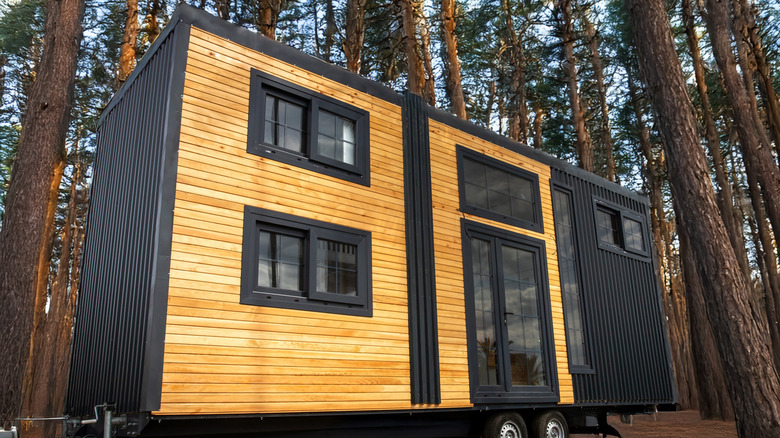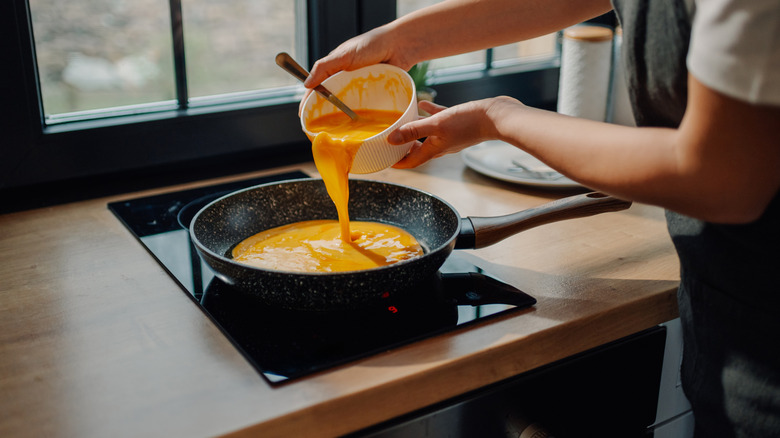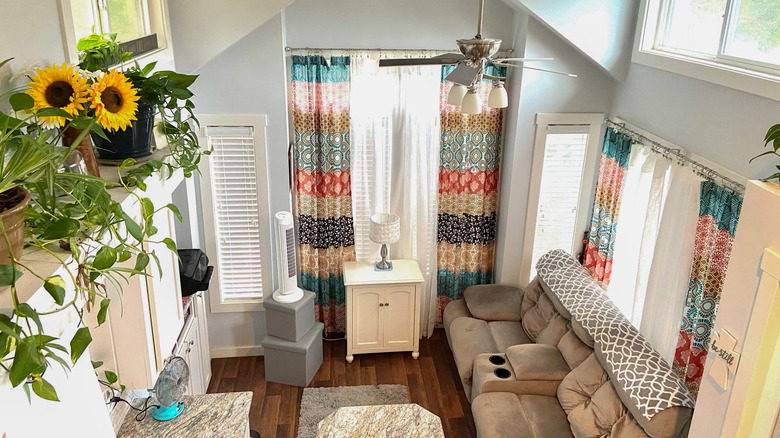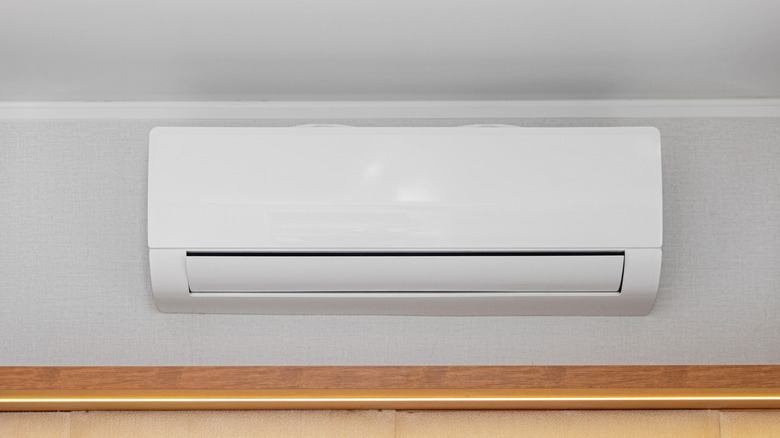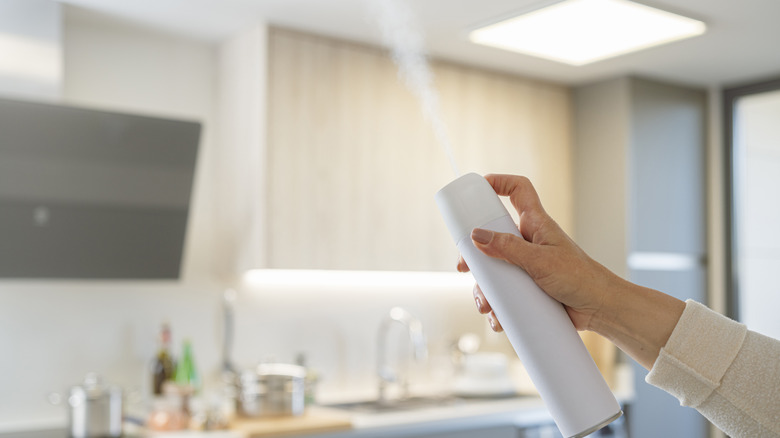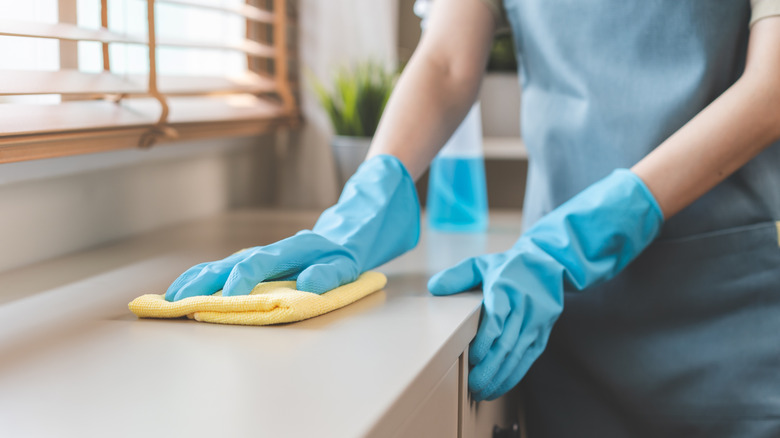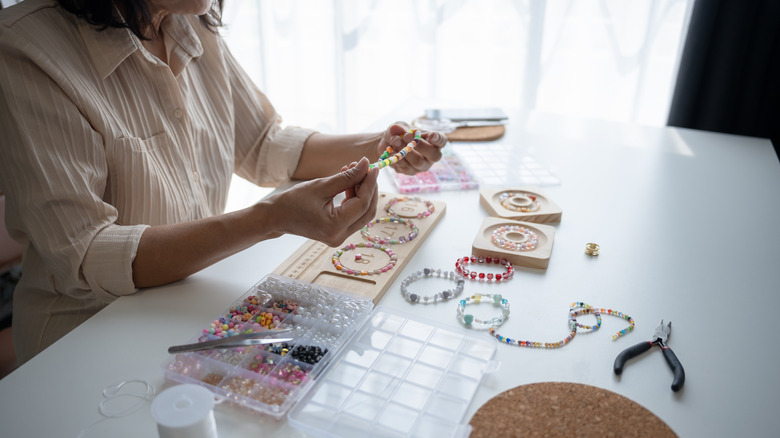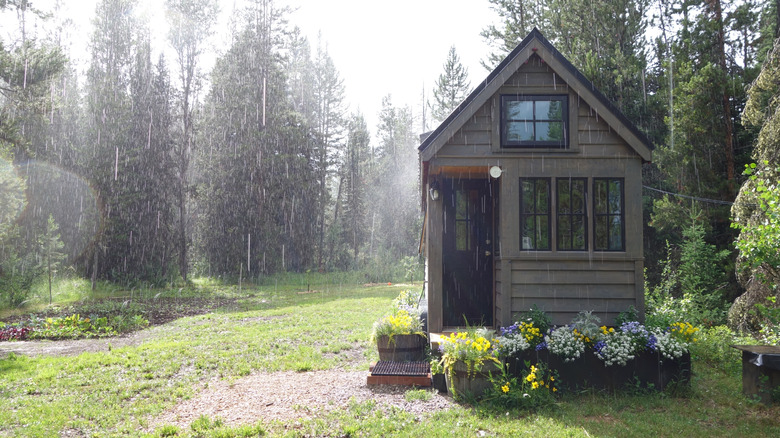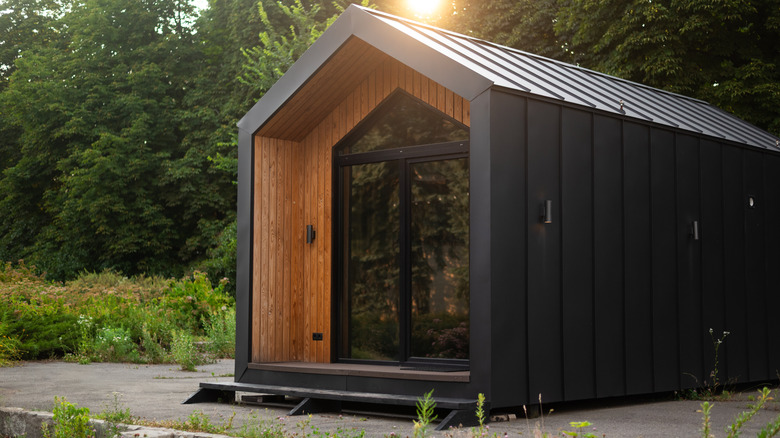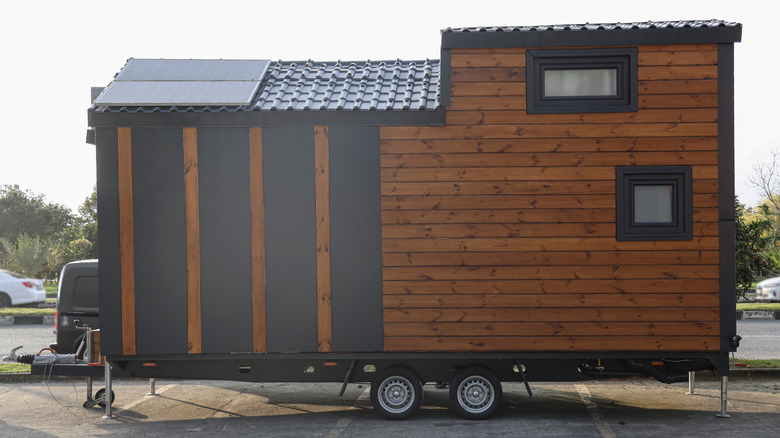12 Hidden Downsides To Living In A Tiny House
We may receive a commission on purchases made from links.
Tiny houses began rising in popularity in the early 2000s and gained even more traction after the 2008 financial crisis led to a housing market crash. Offering around 225 square feet of living space on average, tiny houses encourage a more minimalist lifestyle and come with benefits like affordability, sustainability, and flexibility. However, living in a smaller space can come with obstacles that aren't always obvious at first. It's not just about having less space for guests and clothes, or having to navigate zoning laws; there are other elements of tiny house living that can present challenges, and may even result in people deciding that moving into a tiny home simply isn't feasible for them.
Whether you're in the process of trying to build your own tiny house or just want to learn more about the true experience of downsizing, there are lots of things to consider. Keep reading to learn about 12 hidden downsides to living in a tiny house.
You may pay more for appliances
For many people, affordability is one of the biggest draws of tiny house living. However, just because the home itself is more affordable than a traditional house doesn't mean those cost savings trickle down into every area of tiny home living. Purchasing appliances for a tiny home can be surprisingly expensive since the lack of space means standard-sized items are often a no-go. Since non-standard sizes are not sold in large numbers, they can be more expensive.
One of the best ways to avoid shelling out extra money for appliances is to use standard sizes if/when possible. However, if smaller appliances are a must, you can cut costs by purchasing used or refurbished models. Additionally, some mainstream appliance brands, like Whirlpool, have started making appliances for smaller spaces. Going with one of these options may be more cost-effective than purchasing non-standard appliances marketed as being customized for tiny homes.
There isn't much privacy
Not only do tiny houses have limited square footage, but many designs also lack walls and doors to create separation between areas. If you're the kind of person who likes to duck off into a separate room for some alone time, this can be a big challenge when living in a tiny house with another person (or other people). Even something as simple as finding space to have a private phone conversation can be difficult in a tiny home.
Although tiny house living likely won't give you the same level of privacy that comes with more traditional housing options, there are still ways to make your home feel like it has separate spaces. Tiny house aficionados recommend using dividers and partitions. Both of these options are removable and portable, which allows you to use them when necessary and put them away when you're ready for your home to feel more open.
Humidity and moisture can be a problem
Humidity probably isn't something that comes to a lot of people's minds when they think about tiny houses, but it's definitely something to consider. Tiny houses lack the ductwork that is found in traditional homes. This ductwork allows for proper ventilation and reduced humidity. In addition, the lack of ductwork makes tiny houses more susceptible to moisture buildup, which can lead to mold and mildew.
When considering heating and cooling options for a tiny house, it's important to consider the placement of vents and exhaust fans. Ductless mini-split systems can be a great option for tiny houses. Unfortunately, however, mini-split systems can be very expensive, with an average installation cost of $19,500, so they may not be an affordable option for everyone. If you're looking for a more cost-effective HVAC option for a tiny house, window air conditioning units can work for cooling, and space heaters can work for heating.
Lack of food storage
Tiny houses don't just come with a lack of living space; there's also a lot less space to store things like food and other necessities for your kitchen. This means that you may have to change the way you grocery shop, which can be especially challenging for households with more than one person. For example, if you're used to buying things in bulk, that may not work in a tiny house. However, with a little strategic thinking, you can make the most of the space you do have.
For those who are thinking of moving into a tiny house but haven't yet bought (or built) one, now is the perfect time to start planning your ideal tiny kitchen setup so that you can ensure that you have a space that will be functional for you. However, if you're already past that point and have to make do with the setup you currently have, you can make the most of space by using shelf risers, stacking items, and using jars to store dry goods.
Tiny houses can get stinky
Nobody wants to be known as the person whose house has a strange odor. However, tiny houses lend themselves to smells — good and bad — taking over. Since tiny houses are essentially small open spaces, it can be very easy for scents to fill the entire home. Things like leaving food out or leaving wet towels lying around can have an impact on the overall smell of your tiny home.
Cleaning is one of the most important things to do to prevent smells from overwhelming your tiny house. In addition to things like mopping, sweeping, and dusting, you'll also want to pay extra close attention to your kitchen, as this is where a lot of smells can originate. Be sure to scrub the sink, clean out the refrigerator, and even clean your garbage can. Opening the windows regularly is another great way to prevent smells from becoming an issue in your tiny house.
Tiny houses can get dirty quickly
Some people may be under the impression that bigger homes require more frequent cleaning than tiny houses, but that may not be the case. Tiny houses can actually get dirty really quickly because less space allows for clutter to accumulate more easily. On top of that, a mess or spill in one area of the house can leave the entire space looking dirty because of the minimal separation. For households with multiple people and/or pets, it can be particularly challenging to keep the space looking its best at all times.
According to experts, it's important to make time to clean every day; even just 20 minutes can make a big difference. Things like decluttering, dusting, and organizing can help ensure that your home never gets too messy. Experts also recommend deep cleaning your tiny house between one and three times per year. Pro tip: When cleaning, you may want to consider using non-toxic cleaning products. Not only is this eco-friendly, but it can help you avoid filling your small space with harsh chemicals.
Lack of space for hobbies
If you're a homebody who likes to relax at home while enjoying your hobbies, this one is for you. People who have hobbies that take up a lot of space or require a lot of accessories may feel limited by living in a tiny house. For example, you might not have space for things like easels and other art supplies, skis, gym equipment, music equipment, etc.
If giving up your hobbies is out of the question, that's something you'll definitely need to think about before moving into a tiny house. However, if you're open to taking on new hobbies, you'll want to pick things that you can do comfortably and easily in a small space. Some hobbies that are great for small spaces include board games, puzzles, photography, and listening to audiobooks. You may also want to take up hobbies that you can do outside of the house.
Tiny houses are more susceptible to damage from extreme weather
According to the United States Environmental Protection Agency, weather conditions have been changing as a result of a rise in global temperature. This can lead to extreme weather events becoming more common and more powerful. For people living in tiny houses, this can be a serious concern. Tiny houses typically don't have the same foundations as traditional homes, which leaves them at risk of blowing over in high winds.
Fortunately, there are things you can do to prepare your tiny home for extreme weather. If you have a tiny house on wheels, you may want to invest in a Tie-Down kit to keep your home secure. Even if you have a tiny house that has a concrete foundation, you can secure your home using metal strapping around the entire frame. It's also important to regularly inspect things like the roof and windows to ensure that there is no damage that will make your home even more vulnerable in harsh weather conditions.
Tiny houses can be difficult to resell
When many people purchase a home, they consider it an investment and often hope to eventually resell it for a profit. That can be a bit challenging when it comes to tiny houses. While these houses tend to be easier to buy in the sense that they're more affordable than traditional builds, tiny houses — especially ones on wheels – don't usually appreciate in value because they are typically considered personal property as opposed to real estate.
Despite the fact that tiny houses aren't generally considered a strong investment, ensuring that your home is well-built and properly maintained can help it retain some of its value. Additionally, tiny houses that are used as accessory dwelling units near a traditional house can appreciate as the land it is on appreciates, so it's important to pick your plot wisely and consider the market in the area.
Weight restrictions
If you're thinking about moving into or building a tiny house on wheels, weight is something that should definitely be taken into consideration. Weight limitations mean that, during the building phase, certain design elements, such as heavy stone countertops, might not be an option for you. Plus, you'll also have to be aware of what furniture and appliances you're bringing into your home and how much they weigh.
While there is no universal weight limit when it comes to tiny houses, the size of the home's axle will dictate how much weight it can safely carry. In addition, there may be local regulations that dictate how heavy a tiny home can be. If you plan to tow your tiny house, you'll need to know the weight restrictions for the areas you plan to travel through, in addition to the weight limit of the trailer you'll be towing your tiny house with.
Insuring your tiny home can be a challenge
Tiny houses may not be as expensive as traditional houses, but an average cost of $67,000 is still a pretty big chunk of change for most people. And as with other major expenses, insurance is a key consideration. Unlike traditional homes, though, getting insurance for a tiny house can be complicated, and it gets even more complex if your tiny home is a DIY build. In most cases, a standard homeowners insurance policy won't be an option for a tiny house. Instead, most carriers will offer an RV or mobile home policy.
In most cases, your tiny home will need to pass inspections and meet local regulations in order to be eligible for insurance. If your tiny house meets the requirements of an accessory dwelling unit, it may even be possible to add coverage through your existing policy. Keep in mind, however, that insurance is not legally required, so some people may choose to forego coverage entirely.
Tiny houses may not be suitable for people with mobility issues
Many tiny houses are designed with a loft-style bedroom that can only be accessed by climbing steep stairs or a ladder. For people with mobility issues, this can be extremely difficult and could even be impossible. Plus, small spaces, tight bathrooms, and narrow doorways can also be tough to navigate for wheelchair users or those who struggle with walking or standing. Even if you don't have mobility issues, the tight space is still something worth considering, as physical ability can change due to things like age, injury, and/or illness.
Sadly, many standard tiny houses simply aren't made with mobility differences in mind. However, if you're building your own tiny house, you can design it to your liking. There are also some builders who are mindful of accessibility. Cottage Depot, for example, offers a 440-square-foot tiny home that was designed to be accessible by keeping everything on one floor.
